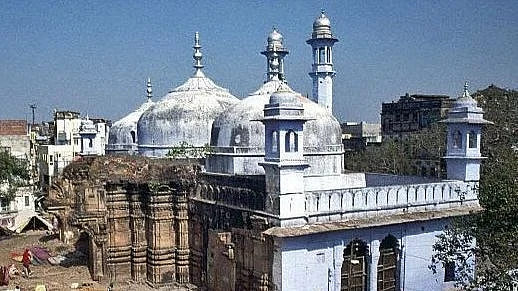(This is the twelfth in a series of insightful reports from the ground, titled The Race From India to Bharat. The author travels all across India as 960 million voters get ready to celebrate the largest festival of democracy in the world: the 2024 Lok Sabha elections. What do ordinary Indians think and feel about the past, present, and future of India? Are they convinced that the old fault lines are healing?)
(Read part one here, part two here, part three here, part four here, part five here, part six here, part seven here, part eight here, part nine here, part 10 here, and part 11 here.)
The author had gone to the Ram Temple and Saryu Ghat at Ayodhya on 15 February at 4.30 am. On 8 March, which was Maha Shivratri, the author went to the Kashi Vishwanath Temple and Dasaswamedh Ghat at 4.30 am. Three similarities and one difference caught the attention of the author.
The first similarity was the unexpected cleanliness in both places. The second was the sheer number of devotees standing in queues that stretched for miles. The third was the astonishing number of devotees from South India. But there was a difference too.
Ayodhya seemed to be all about faith, spirituality and sheer devotion. There were scores of people weeping, even as they chanted Jai Siya Ram in a metronomic manner.
Kashi too had faith and devotion in abundance. But even that early in the morning, there was a tinge of political Hindutva as numerous people danced to the devotional songs being blared. In Kashi, it was more Jai Shri Ram than Jai Siya Ram. I know the two mean the same. But you also know that the context is different.
The previous evening, when the author had stepped out of the horribly expensive hotel for a stroll, there were large groups of youngsters now and then passing through crowded roads with DJ music and loud, reverberating chants of Jai Shri Ram. The message was unmistakable.
At about 7 AM on Maha Shivratri, the author approached a lady police officer who was attired in a crisply ironed uniform. I wanted to ask her if I could take out my car from the Gowdolia Chowk parking towards Azamgarh and get back to the same place in a few hours. She smiled sardonically and asked, “Do you really think you can take a car out in this crowd? No, no car can leave or enter till the evening. You might be able to exit. But you won’t be allowed back today”.
I was fumbling with a Rudraksha Mala that I had just bought for my mother. Perhaps she noticed that and also the tick on my forehead. In a parting gesture, she smiled and said, Jai Shri Ram.
I stood near the police assistance booth from where one could see rituals being telecast on a giant screen. While thinking about Azamgarh, a thought struck me that morning about the tides of history. Both the Rashtriya Swayamsevak Sangh (RSS) and the Communist Party of India (CPI) were formally launched in India about 100 years ago in 1925. Both were committed to using ideology as an instrument to influence the vast masses of India.
The CPI dreamt of a new world where the proletariat would lord it over. The RSS dreamt of Hinduism and Hindutva regaining its lost glory after 1000 years of invasions and ghulami. For many decades since 1925, it did appear as if the communists had a message that resonated more powerfully with the “unwashed masses”. The Hindutva project of the RSS appeared obsolete and past its sell-by date.
Standing there amidst hundreds of thousands of devotees, the author realised two things: first, the RSS has decisively decimated the communists when it comes to connecting with the masses in India. Second, the “Hindu” resurgence is so potent that any political party that is perceived as “anti-Hindu” is doomed in Indian electoral politics barring a few states and pockets in contemporary times.
The author has never been comfortable with the militant in-your-face Hindutva often seen these days. But then he recalled that Nobel Prize-winning author V S Naipaul had written long back that the resurgence of Hinduism would be accompanied by some ugliness.
Forget ugliness. On 7 March, the author spent two hours in the evening watching the Ganga Aarti. It is impossible to miss the pride with which devotees (call them tourists if you want to) from every corner of India wear their Hindu marker as a matter of pride. The author has seen the Ganga Aarti before. But there was something tectonic about the shift in mindset.
Hundreds of young boys and girls in their early twenties were actually passionately involved in the elaborate rituals that formed the Ganga Aarti. Thunderous chants of Mahadev and Jai Shri Ram seemed to send ripples through the nearby Ganga where thousands of pilgrims were watching the rituals from boats.
Frankly, even for a non-serious follower of Hinduism like me, the experience was magical, mystical, and overwhelming.
While exiting the parking lot to drive towards Azamgarh, Siwan, and Patna the next morning, the author realised he hadn’t asked even one person about the Lok Sabha candidate — Narendra Modi. I had thought since the results were a foregone conclusion, what’s the point? To fulfil my role as a hack, I did ask the parking lot official about Modi.
His Varanasi-style sarcastic answer that went on for about 45 seconds basically said, “Why are you asking? What’s the point?”
(Sutanu Guru is the Executive Director of the CVoter Foundation. This is an opinion article and the views expressed above are the author’s own. The Quint neither endorses nor is responsible for them.)
